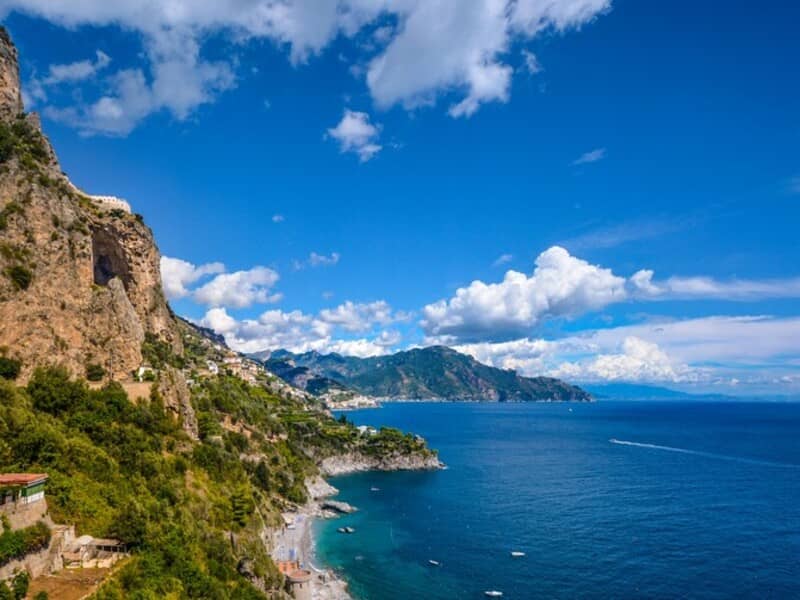Overlooking the Tyrrhenian Sea, the Amalfi Coast is one of the 55 Italian sites included by UNESCO in the World Heritage List: it appears as a balcony suspended between the sea and the slopes of the Lattari Mountains, in a succession of valleys and headlands between coves, beaches and terraces planted with citrus fruits, vines and olive trees.
The entire area covers 11,231 hectares between the Gulf of Naples and the Gulf of Salerno and includes 16 beautiful municipalities in the province of Salerno.

The best way to admire the Amalfi Coast in all its entirety is to take an excursion on the Path of the Gods: on the clearest days, you can admire this corner of paradise in all its splendor. It is a nature trail on the Lattari mountains, suitable for walks and excursions, which runs along the entire coastal strip for 7 km. In the hamlet of Positano, Nocelle, is perhaps the most interesting part of the Path of the Gods, in fact it is here that the landscape becomes suggestive thanks to the alternation of pine forests, caves to explore and above all spectacular views of the Amalfi Coast.

Among the most famous places there is Amalfi, the town founded in the fourth century BC that gives its name to the Coast.
Ancient Maritime Republic, Amalfi held for a long time the monopoly of trade in the Tyrrhenian Sea, exporting Italian products (wood, iron, weapons, wine and fruit) to Eastern markets and buying in exchange spices, perfumes, pearls, jewelry, fabrics and carpets to trade in the West.
Here, once upon a time, there were the mills that fed the factories for the production of the “Amalfi paper“, which already in 1220 was considered so valuable that Frederick II forbade its use for public acts.
To see absolutely the famous Duomo, dedicated to St. Andrew, which is accessed through an imposing staircase; a spectacle to see from the top of the staircase the square below and is even more so in the evening when everything is illuminated.
Among other things to do in Amalfi we suggest you to taste the specialty of the local gastronomy: the limoncello, produced with the lemons of the Amalfi Coast IGP.

Positano: the vertical city stuck in the rock, where the stairs replace the streets.
It is the first town you meet on the Amalfi Coast going from west to east. Strolling through its picturesque, sun-kissed streets is an exceptional experience to say the least. The stairs of the pretty little houses, set one on top of the other, intertwine to create a fairytale environment that catapults directly into a fragrant mirage and connects the upper part of the city to the beach. The main beaches of Positano are the Spiaggia Grande and Fornillo, both within walking distance from the city center.
Beyond the beauty of its beaches, universally recognized, Positano is frequented by people from all over the world and the most diverse lifestyles. One of the reasons for the popularity of Positano are the beach clothes. Colorful cloths, bags, pareos in linen or cotton and bikinis. In the famous 60’s, in fact, the city discovered and experienced the interesting phenomenon of “Positano Fashion“.
A city to live with the heart ready to receive emotions also for all the spectacular architectural works that hides in its historic center. Impossible not to fall in love with its Church of Santa Maria Teresa dell’Assunta, the fulcrum of the town and with a majolica dome that shines under the local sun.

All the colours of the Amalfi Coast, the blue of the sea, the green of the woods, the orange of the citrus fruits, seem to meet in Vietri, in the enamels and decorations of the ceramics produced since 1600 in this beautiful town of Campania World Heritage since 1997.
Vietri has been famous for centuries for the beauty of its majolica tiles: with these splendid materials are covered the internal altars, the dome and the spire of the bell tower of the parish church of S. Giovanni Battista (1732), whose colours are visible from afar and which houses splendid 17th and 18th century paintings.
Strolling around Vietri is a continuous surprise, it often happens to come across buildings decorated with splendid ceramics, as it happens for the façade of the 17th century Archconfraternity of the Annunziata and the Rosary: the ceramics are one with the landscape.
Vietri and the other centres in the area, including Conca dei Marini, thus become an open-air museum, with numerous shops displaying and selling ceramic objects of all kinds: plates, glasses, plates.

Ravello is one of the most suggestive destinations of the whole Amalfi Coast.
The Cathedral is one of the (former) oldest cathedrals in Italy and its first construction dates back to 1086.
Inside the Cathedral of Ravello, today no longer the centre of the diocese that no longer exists, but the seat of the municipal parish, there is also the Museo dell’Opera, in the crypt of the church, which houses Roman cinerary urns, reliquaries from the early Christian era and ancient artefacts, and the medieval and modern art gallery.
Villa Rufolo, the real jewel of Ravello, is a splendid villa, exceptional from an architectural and aesthetic point of view, which contributes to create a timeless beauty that has bewitched practically everyone who has passed through these parts (Wagner made it his meditation refuge).
Absolutely to visit the most important rooms of the villa, among which we can only mention:
The entrance tower: it was built exclusively for aesthetic reasons; the statues representing the seasons are one of the details that fascinate those who come to the villa for the first time;
The beautiful cloister, the main tower that allows you to enjoy an excellent view, both towards the sea and the mountains.
The well: Wagner caught a glimpse of his magical enchanted garden of Klingsor.
Finally the incredible Belvedere that offers a beautiful view over the whole area of the Coast.


